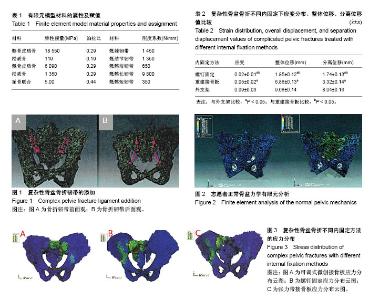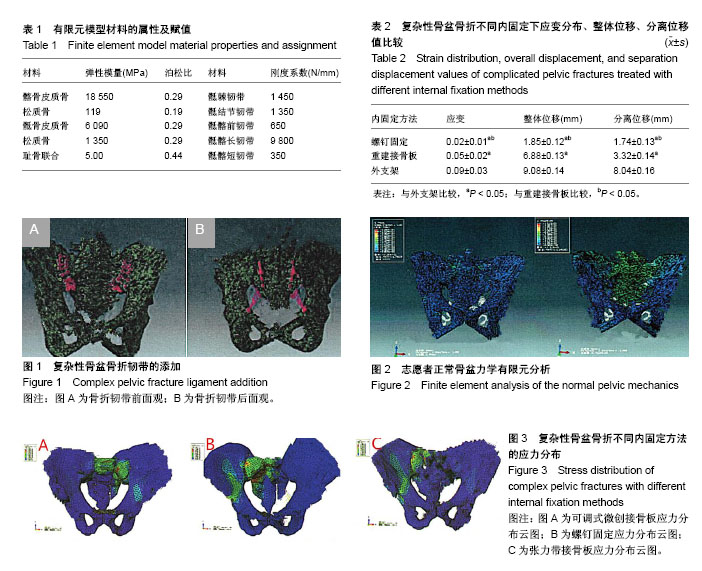| [1] 张永强,章莹,夏远军,等.髋臼部T形骨折四种不同内固定方式的生物力学有限元分析[J].中国临床解剖学杂志, 2017,35(3):312-317.[2] 柳超,王前,张杰峰,等.不同内固定手术方式治疗寰枢椎复合骨折稳定性的有限元分析[J].中国脊柱脊髓杂志, 2015,25(10):904-911.[3] Tao W,Wei C,Qi Z,et al. Biomechanical comparison of two kinds of internal fixation in a type C zone II pelvic fracture model. Chin Med J. 2015; 128(17):2312-2317.[4] 代元元,章莹,夏远军,等.四种不同内固定方式治疗髋臼前柱低位骨折的有限元分析比较[J].中华创伤骨科杂志, 2016,18(8):702-707.[5] Yao F,He Y,Qian H,et al. Comparison of biomechanical characteristics and pelvic ring stability using different fixation methods to treat pubic symphysis diastasis: A finite element study. Medicine. 2015; 94(49):e2207.[6] 张晟,胡岩君,余斌.不同内固定方式固定PauwelsⅢ型股骨颈骨折模型的有限元分析[J].中国矫形外科杂志, 2017,25(2):163-169.[7] 潘昌武,刘曦明,蔡贤华,等.微型联合重建接骨板内固定治疗髋臼后壁骨折坐位下的三维有限元分析[J].中国矫形外科杂志, 2015,23(2): 160-164.[8] 王锋,汪国栋,刘曦明,等. 椎弓根螺钉置钉法和常规置钉法在骨盆骨折外固定术中的疗效比较[J]. 中华创伤杂志,2016,32(5):410-416.[9] Miskimins R,Decker M,Hobby B et al. Complications of pelvic ring fixation in patients requiring laparotomy. J Surg Res. 2015;199(1): 244-248.[10] 董石磊,蔡贤华,王志华,等.对侧骨盆环稳定性对前柱伴后半横行髋臼骨折动力化前路方形区钛板螺钉系统内固定影响的有限元分析[J].中华实验外科杂志,2015,32(4):858-860.[11] 盛伟,纪爱敏,陈长胜.基于有限元分析的股骨干骨折内固定系统多因素的正交试验设计[J].生物医学工程研究, 2017,36(2):146-151.[12] 贺宇,周东生,邱贵兴,等.四种内固定方式治疗耻骨联合分离生物力学特性的有限元分析[J].中华创伤骨科杂志, 2017,19(4):317-322.[13] Zhang BF,Zhang H,Wang PF,et al. The role of ultrasonography in examination of the stability of Tile-B2 pelvic fractures: 7 case reports and a literature review. Medicine. 2017; 96(38):e8100.[14] 李斯铭,王冬梅,曲爱丽,等.钉棒内固定TileB2型骨盆骨折的生物力学效果[J].医用生物力学,2016,31(3):240-246.[15] 余伟波,梁德,叶林强,等.3种不同后路内固定方式及其横连治疗胸腰段骨折的力学性能比较[J].医用生物力学,2016,31(2):142-147.[16] 董巍,刘创建,张天一,等.基于有限元法的VancouverB1型股骨假体周围骨折内固定力学分析[J].第二军医大学学报,2017,38(2): 253-257.[17] Jazini E,Klocke N,Tannous O,et al. Does lumbopelvic fixation add stability? A cadaveric biomechanical analysis of an unstable pelvic fracture model. J Orthop Trauma. 2017;31(1):37-46.[18] Keene DJ,Willett K,Lamb SE. The immediate effects of different types of ankle support introduced 6 weeks after surgical internal fixation for ankle fracture on gait and pain: a randomized crossover trial. J Orthop Sports Phys Ther. 2016; 46(3):157.[19] 刘海波,雷建银,张宝成,等.前后路内固定治疗Ⅱ型不稳定Hangman骨折的有限元分析[J].医用生物力学, 2015,30(4):326-331.[20] 刘建斌,刘敏,马林,等.防旋髓内钉和InterTan固定A3型股骨转子间骨折:生物力学变化的有限元分析[J].中国组织工程研究, 2015,19(26): 4242-4246.[21] Ikemura S,Yamashita A,Harada T,et al. Clinical and imaging features of a subchondral insufficiency fracture of the femoral head after internal fixation of a femoral neck fracture: a comparison with those of post-traumatic osteonecrosis of the femoral head. Br Jo Radiol. 2016; 89(1060):20150725.[22] 万全会.后踝关节骨折不同内固定方式的生物力学性能对比[J].中国组织工程研究,2015,19(48):7806-7810.[23] 倪明,牛文鑫,梅炯,等.交叉螺钉与钢板内固定治疗SanderⅢ型跟骨骨折的有限元分析[J].医用生物力学, 2015,30(6):501-505.[24] Lindsay A,Diwan A,Templeman D. Is closed reduction and percutaneous fixation of unstable posterior ring injuries as accurate as open reduction and internal fixation? J Orthop Trauma. 2016; 30(1):29.[25] Collinge CA,Crist BD. Combined percutaneous screw fixation with screw augmentation using resorbable calcium phosphate cement for the treatment of osteoporotic sacral fractures.J Orthop Trauma. 2016;30(3):90-95.[26] 樊健,李山珠,袁锋,等.股骨小转子未固定的抗旋髓内钉治疗Evans- JensenⅢ型转子间骨折的有限元分析[J].中华实验外科杂志, 2016, 33(12):2794-2796.[27] Gu R,Huang W,Yang L,et al. Comparisons of front plate, percutaneous sacroiliac screws, and sacroiliac anterior papilionaceous plate in fixation of unstable pelvic fractures. Medicine. 2017;96(36):e7775.[28] 仇道迪,周东生,许维澄,等. 3D打印技术在陈旧性骨盆髋臼骨折治疗中的应用[J]. 中华创伤骨科杂志, 2017, 19(7):624-629.[29] 李春光,桑锡光,石恩东,等. 髂骨瘀斑征在骨盆骨折合并腹部空腔脏器损伤中的诊断价值[J].中国矫形外科杂志, 2017,25(16): 1478-1482.[30] Daniel IL, Anne-Sophie MB, Droeser RA, et al. Ten years’ follow-up on combined palmar and dorsal internal fixation of complex distal radius fractures. Medicine. 2016;95(18):e3509.[31] 杨晓东, 刘涵, 周忠信,等. 髂内动脉栓塞及预置腹主动脉球囊在复杂骨盆骨折手术中的应用[J]. 中华骨科杂志, 2017, 37(1):11-16.[32] Marie C. Strength analysis of clavicle fracture fixation devices and fixation techniques using finite element analysis with musculoskeletal force input. Med Biol Eng Comput. 2015;53(8): 759.[33] Zielinski SM, Heetveld MJ, Bhandari M, et al. Implant removal after internal fixation of a femoral neck fracture: effects on physical functioning. J Orthop Trauma. 2015;29(9):e285. |

